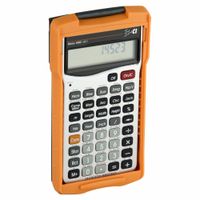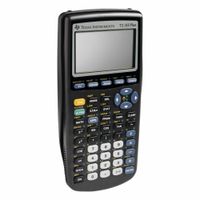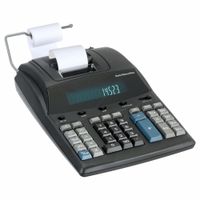Call +(254) 703 030 000 / 751 483 999 / 721 704 777
- Home
- Office Supplies
- Calculators
.....Read More
Frequently Asked Questions
What is the best calculator for basic arithmetic?
The best calculator for basic arithmetic is the Casio FX-260 Solar II. It is a reliable, user-friendly, and affordable option that is ideal for everyday calculations. The calculator is solar-powered, ensuring it is always ready for use without the need for battery replacements. Its design is compact and lightweight, making it easy to carry around in a pocket or bag.
The Casio FX-260 Solar II features a clear, easy-to-read display that can show up to 10 digits, which is sufficient for most basic arithmetic tasks. The buttons are well-spaced and responsive, providing a comfortable user experience. It includes essential functions such as addition, subtraction, multiplication, and division, along with percentage and square root calculations.
This calculator is also approved for use in standardized tests like the SAT and ACT, which speaks to its reliability and functionality. Its durable construction ensures it can withstand regular use, making it a long-lasting tool for students, professionals, and anyone needing quick arithmetic solutions.
Overall, the Casio FX-260 Solar II stands out for its simplicity, efficiency, and practicality, making it the best choice for basic arithmetic needs.
How do graphing calculators work?
Graphing calculators are handheld computing devices designed to plot graphs, solve simultaneous equations, and perform other tasks with variables. They work by combining hardware and software components to process mathematical functions and display results visually.
At the core, a graphing calculator contains a microprocessor, which executes instructions and performs calculations. It also includes memory components: RAM for temporary data storage and ROM for permanent storage of the operating system and built-in functions. The operating system manages the calculator's functions, including input processing, calculations, and output display.
Users input mathematical expressions via a keypad. The calculator's software interprets these inputs, converting them into a form the microprocessor can understand. For graphing, the calculator evaluates the function over a specified range of values, calculating corresponding y-values for each x-value. These (x, y) pairs are plotted on a pixel-based LCD screen, forming the graph.
Graphing calculators often feature a menu-driven interface, allowing users to access various functions like trigonometry, calculus, and statistics. Advanced models support programming, enabling users to write custom scripts for complex calculations.
The display is typically a monochrome or color LCD, capable of showing graphs, text, and sometimes even animations. The resolution and size of the screen determine the detail and amount of information that can be displayed.
Power is usually supplied by batteries, with some models featuring solar panels for extended life. Connectivity options, such as USB ports or wireless capabilities, allow data transfer between calculators or to a computer.
Overall, graphing calculators are powerful tools for students and professionals, providing a portable means to perform complex mathematical tasks and visualize data.
What features should I look for in a scientific calculator?
When selecting a scientific calculator, consider the following features:
1. **Functionality**: Ensure it supports basic arithmetic, trigonometric, logarithmic, and exponential functions. Advanced models should handle calculus functions like derivatives and integrals.
2. **Display**: Look for a multi-line display to view complex calculations and results simultaneously. A high-resolution screen can improve readability.
3. **Programmability**: Some calculators allow programming for custom functions, which is useful for repetitive calculations.
4. **Graphing Capabilities**: If needed, choose a model that can plot graphs for visualizing functions and data.
5. **Memory**: Check for sufficient memory to store variables, constants, and previous calculations.
6. **User Interface**: A well-organized keypad with intuitive navigation can enhance usability. Look for dedicated keys for frequently used functions.
7. **Durability**: A robust build with a protective case can prolong the calculator's lifespan, especially for fieldwork.
8. **Power Source**: Consider models with dual power options (solar and battery) for reliability.
9. **Connectivity**: Some calculators offer USB or Bluetooth connectivity for data transfer to computers or other devices.
10. **Compliance**: Ensure it meets the requirements for standardized tests or professional exams if needed.
11. **Cost**: Balance features with budget constraints. More advanced features typically increase the price.
12. **Brand and Support**: Opt for reputable brands known for quality and customer support, which can be crucial for troubleshooting and repairs.
13. **Additional Features**: Some calculators offer statistical analysis, matrix operations, and complex number calculations, which can be beneficial for specific fields.
Evaluate these features based on your specific needs and the complexity of tasks you intend to perform.
Can calculators solve algebraic equations?
Yes, calculators can solve algebraic equations, but the extent of their capability depends on the type of calculator. Basic calculators are limited to simple arithmetic operations and cannot solve algebraic equations. However, scientific calculators can handle more complex mathematical functions, including solving simple algebraic equations, often through numerical methods or by allowing users to input equations and solve for a variable.
Graphing calculators are more advanced and can solve a wider range of algebraic equations. They can graph functions, find intersections, and use built-in functions to solve equations symbolically or numerically. These calculators often have features like equation solvers that allow users to input equations and solve for unknowns directly.
Symbolic calculators, or CAS (Computer Algebra System) calculators, are the most advanced type and can solve algebraic equations symbolically. They can manipulate algebraic expressions, perform calculus operations, and solve equations exactly, providing solutions in terms of variables rather than just numerical approximations.
In addition to physical calculators, software-based calculators and apps, such as those found on computers and smartphones, can also solve algebraic equations. These often have capabilities similar to or exceeding those of physical calculators, especially when integrated with powerful mathematical software.
In summary, while basic calculators cannot solve algebraic equations, scientific, graphing, and symbolic calculators, as well as software-based calculators, can solve a wide range of algebraic equations, either numerically or symbolically, depending on their features and capabilities.
How accurate are printing calculators?
Printing calculators are generally accurate for basic arithmetic operations such as addition, subtraction, multiplication, and division. They are designed to handle financial calculations, making them suitable for tasks like balancing checkbooks, calculating taxes, and managing budgets. The accuracy of a printing calculator depends on several factors:
1. **Precision**: Most printing calculators offer precision up to 10-12 digits, which is sufficient for everyday financial calculations. This level of precision ensures that rounding errors are minimized.
2. **Rounding Options**: Many printing calculators come with rounding options (up, down, or 5/4 rounding) to handle decimal places according to user preferences, which can affect the final result slightly but is generally within acceptable limits for financial purposes.
3. **Quality of Components**: The accuracy can also depend on the quality of the calculator's components, such as the keypad and the printing mechanism. High-quality calculators from reputable brands tend to be more reliable and accurate.
4. **Error Checking**: Some models include error-checking features that help identify and correct input mistakes, enhancing overall accuracy.
5. **Environmental Factors**: External factors like power supply (battery vs. AC), paper feed alignment, and wear and tear over time can impact performance and accuracy.
6. **User Input**: Human error in data entry is a common source of inaccuracies. Double-checking entries can mitigate this issue.
Overall, while printing calculators are highly accurate for their intended use, they are not designed for complex scientific or statistical calculations. For such tasks, scientific or graphing calculators are more appropriate. Regular maintenance and careful operation can help maintain their accuracy over time.
What is the difference between a graphing calculator and a scientific calculator?
A graphing calculator and a scientific calculator differ primarily in functionality, display, and intended use.
A scientific calculator is designed for performing a wide range of mathematical operations, including basic arithmetic, trigonometry, logarithms, and exponential functions. It typically features a single-line or multi-line display and is used for solving algebraic equations, statistical calculations, and other scientific computations. Scientific calculators are compact, cost-effective, and suitable for high school and college-level math and science courses.
In contrast, a graphing calculator offers all the functionalities of a scientific calculator but with advanced capabilities. It features a larger, high-resolution display capable of plotting graphs of functions, which is its most distinguishing feature. Graphing calculators can handle complex equations, perform calculus operations, and store multiple functions for comparison. They often include programmable features, allowing users to write and execute custom programs and scripts. These calculators are essential for higher-level mathematics, engineering, and physics courses, where visualizing data and functions is crucial.
Graphing calculators are generally more expensive and bulkier than scientific calculators due to their enhanced capabilities and larger screens. They are often required in advanced high school courses, such as AP Calculus, and in college-level STEM courses. While scientific calculators are sufficient for basic and intermediate math, graphing calculators provide a more comprehensive toolset for tackling complex mathematical problems and visualizing data.
Are construction calculators worth it for DIY projects?
Yes, construction calculators can be worth it for DIY projects. They offer several advantages that can enhance the efficiency and accuracy of your work. These calculators are designed to handle specific construction-related calculations, such as area, volume, angles, and conversions between different units of measurement. This can save time and reduce errors compared to manual calculations.
For DIY enthusiasts, construction calculators can simplify complex tasks like determining the amount of materials needed, such as concrete, lumber, or tiles, which helps in budgeting and minimizing waste. They also assist in calculating dimensions for cutting materials, ensuring precision and reducing the likelihood of costly mistakes.
Moreover, construction calculators often come with built-in functions for common construction tasks, such as stair layout, roof pitch, and rafter calculations, which can be particularly beneficial for those who may not have extensive experience in construction.
While some may argue that smartphone apps can perform similar functions, dedicated construction calculators are typically more robust and reliable, especially in environments where durability and ease of use are important. They are often designed to withstand tough conditions, such as dust and moisture, which are common on construction sites.
In summary, for DIY projects, especially those involving significant construction work, a construction calculator can be a valuable tool. It enhances accuracy, saves time, and reduces the potential for errors, making it a worthwhile investment for both novice and experienced DIYers.
How do I choose a calculator for accounting purposes?
To choose a calculator for accounting purposes, consider the following factors:
1. **Functionality**: Look for calculators with essential accounting functions such as tax calculation, cost/sell/margin, and currency conversion. Ensure it has a memory function to store calculations and a grand total feature for summing multiple entries.
2. **Type**: Decide between a basic, scientific, or financial calculator. For accounting, a financial calculator is often preferred due to its specialized functions like amortization, interest rate calculations, and cash flow analysis.
3. **Display**: Opt for a calculator with a large, clear display. A multi-line display can be beneficial for reviewing previous entries and complex calculations.
4. **Keypad**: Choose a calculator with a responsive and durable keypad. A 10-key layout is standard for accounting, allowing for efficient data entry. Consider models with color-coded keys for frequently used functions.
5. **Printing Capability**: If you need a physical record of calculations, consider a printing calculator. These are useful for auditing and verifying entries.
6. **Portability**: If you need to carry the calculator between locations, consider a compact, lightweight model. For desk use, a larger, more robust model may be preferable.
7. **Power Source**: Decide between battery-operated, solar-powered, or dual-powered calculators. Dual power ensures functionality in various lighting conditions.
8. **Brand and Reliability**: Choose reputable brands known for durability and reliability, such as Casio, Sharp, or Texas Instruments.
9. **Budget**: Set a budget that balances cost with the features you need. While basic models are inexpensive, investing in a quality calculator can enhance efficiency and accuracy.
10. **User Reviews**: Check reviews and ratings to gauge user satisfaction and identify any common issues with specific models.
What are the advantages of using a pocket calculator?
A pocket calculator offers several advantages, making it a valuable tool for various users:
1. **Portability**: Its compact size allows for easy transportation, fitting conveniently in pockets, bags, or briefcases, making it accessible for on-the-go calculations.
2. **Efficiency**: Calculators provide quick and accurate results for arithmetic operations, saving time compared to manual calculations and reducing the likelihood of errors.
3. **User-Friendly**: With a simple interface, pocket calculators are easy to use, requiring minimal instruction, which is beneficial for users of all ages and skill levels.
4. **Cost-Effective**: Generally inexpensive, pocket calculators are an affordable tool for students, professionals, and anyone needing basic computational assistance.
5. **Battery Life**: Many pocket calculators have long-lasting batteries or solar power options, ensuring they are ready for use without frequent recharging or replacement.
6. **Versatility**: Beyond basic arithmetic, many models offer functions for percentages, square roots, and memory storage, catering to a variety of mathematical needs.
7. **Focus**: Unlike smartphones or computers, calculators are dedicated devices that minimize distractions, allowing users to concentrate solely on calculations.
8. **Durability**: Designed to withstand regular use, pocket calculators are typically robust, withstanding drops and daily wear and tear.
9. **Educational Tool**: They are widely used in educational settings, helping students learn and practice mathematical concepts effectively.
10. **Accessibility**: For individuals with limited access to digital devices, pocket calculators provide an essential tool for performing necessary calculations.
Overall, pocket calculators are practical, reliable, and efficient tools that support a wide range of mathematical tasks, making them indispensable in both educational and professional environments.
How do calculators perform complex computations so quickly?
Calculators perform complex computations quickly through a combination of efficient hardware design and optimized algorithms. At the core of a calculator is a microprocessor, which is a small, powerful chip designed to execute arithmetic and logic operations. This microprocessor operates using binary code, allowing it to process instructions at high speeds.
The speed of computation is largely due to the use of integrated circuits (ICs) that contain millions of transistors. These transistors switch on and off rapidly, enabling the calculator to perform multiple operations in a fraction of a second. The architecture of the microprocessor is designed to handle basic operations like addition, subtraction, multiplication, and division with minimal delay.
Calculators also use algorithms that are specifically optimized for speed and efficiency. For example, multiplication and division are often performed using methods like the shift-and-add algorithm or the Booth's algorithm, which reduce the number of steps required compared to traditional methods. For more complex functions like trigonometry or logarithms, calculators use precomputed tables and interpolation techniques to deliver results quickly.
Additionally, calculators have a limited set of functions compared to general-purpose computers, allowing them to be optimized for specific tasks. This specialization means that the hardware and software are finely tuned to perform these tasks as efficiently as possible.
The combination of high-speed microprocessors, efficient algorithms, and specialized hardware allows calculators to perform complex computations almost instantaneously, providing users with quick and accurate results.



